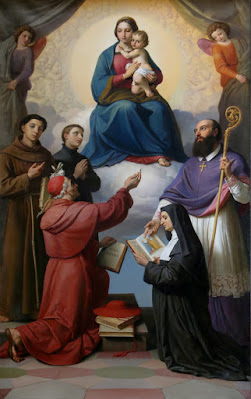 |
| Peter von Cornelius Joseph revealing himself to his Brothers ca. 1816-17 detached fresco Alte Nationalgalerie, Berlin |
 |
| Wilhelm von Schadow Joseph interpreting Dreams in Prison 1816-17 detached fresco Alte Nationalgalerie, Berlin |
 |
| Wilhelm von Schadow Joseph's Bloody Coat shown to Jacob 1816-17 detached fresco Alte Nationalgalerie, Berlin |
 |
| Wilhelm von Schadow A Knight Templar ca. 1832-33 oil on canvas private collection |
 |
| Johann Friedrich Overbeck The Way to Calvary ca. 1830 watercolor private collection |
 |
| Friedrich Olivier Study for Fleeing Archer 1818 drawing, with watercolor Museum Kunstpalast, Düsseldorf |
 |
| Johann Evangelist Scheffer von Leonhardshoff Académie 1814 drawing Museum Kunstpalast, Düsseldorf |
 |
| Julius Schnorr von Carolsfeld Académie with Two Figures 1812 drawing private collection |
 |
| Julius Schnorr von Carolsfeld The Wedding Feast at Cana 1819 oil on canvas Kunsthalle, Hamburg |
 |
| Julius Schnorr von Carolsfeld Reynard the Fox (after an engraved illustration for a volume by Goethe) ca. 1850 porcelain vase by Wilhelm von Kaulbach private collection |
 |
| Joseph von Führich Virgin and Child with St Adelheid and St Francis 1835 oil on panel Belvedere Museum, Vienna |
 |
| Joseph von Führich The Good Shepherd ca. 1840 drawing Museum Kunstpalast, Düsseldorf |
 |
| Philipp Veit The Immaculate Conception 1830 oil on canvas Chiesa di Santissima Trinità dei Monti, Rome |
 |
| Johann Michael Wittmer Virgin and Child in Glory with Saints ca. 1850 oil on canvas Chiesa di Santa Rosa, Viterbo |
 |
| Johann Michael Wittmer Raphael's first sketch for the Madonna della Sedia (detail) 1853 oil on canvas Royal Collection, Great Britain |
"After achieving celebrity in the early decades of the nineteenth century, the Nazarenes were already falling into disfavor in Germany by the early 1840s. Jakob Burckhardt, for one, judged them severely. Like Goethe before him, he disliked what he saw as their subordination of the visual to the conceptual, notably their placing of art in the service of religion, their cult of the Italian "Primitives" and of German and Netherlandish art of the fifteenth and sixteenth centuries, and their rejection of the direction in which painting had evolved since Raphael. The Nazarenes and their principal advocates, notably Friedrich Schlegel, had denounced the great Venetian colorists as marking the first step in a steady degradation of art in modern times, whereas Burckhardt deeply admired the Venetians' "Existenzbilder" (as he called them) for their sensuous celebration . . . of the beauty of worldly existence."
"It is not easy to form an independent opinion in the matter, since the Nazarenes are, to say the least, poorly represented in our great public collections. One must either travel to Germany to see them or content oneself with reproductions in books and exhibition catalogues. In fact, the virtual absence of paintings and drawings by the Nazarenes from public collections in the United States, Great Britain, and France, the dearth of any courses about them or, for that matter, about nineteenth-century German art in general, in our college and university art history programs, and the resulting public ignorance of this body of work constitue in themselves a curious problem of historiography as well as aesthetics."
"Our experience as viewers of art and the way our sensibility has been shaped almost guarantee a tepid response to the Nazarenes' conscientious, beautifully balanced, but undramatic compositions, in which movement, physical and psychological, often seems either held in suspension or highly conventionalized. With their use of flat local colors and their eschewing of all dramatic light and color effects, the Nazarenes seem to want to deny the materiality of the painting and to direct the viewer's attention instead to more abstract and "spiritual" qualities like line, composition, color harmonies, and, ultimately, moral and religious meaning."
– Lionel Gossman, from Unwilling Moderns: The Nazarene Painters of the Nineteenth Century, published in Nineteenth-Century Art Worldwide (volume 2, issue 3, autumn 2003)